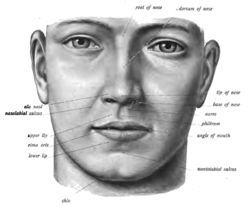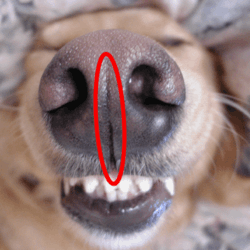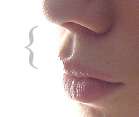Philtrum
The philtrum (Latin: philtrum, Greek: φίλτρον philtron, lit. "love charm"[2]), or medial cleft, is a vertical indentation in the middle area of the upper lip, common to many mammals, extending in humans from the nasal septum to the tubercle of the upper lip. Together with a glandular rhinarium and slit-like nostrils, it is believed to constitute the primitive condition for at least therian mammals. Monotremes lack a philtrum, though this could be due to the specialised, beak-like jaws in living species.[3]
| Philtrum | |
|---|---|
 Philtrum visible at centre | |
 Dog philtrum | |
| Details | |
| Precursor | Medial nasal prominence[1] |
| Identifiers | |
| TA | A05.1.01.007 |
| FMA | 59819 |
| Anatomical terminology | |
Function
In most mammals, the philtrum is a narrow groove that may carry dissolved odorants from the rhinarium or nose pad to the vomeronasal organ via ducts inside the mouth.[4]
For humans and most primates, the philtrum survives only as a vestigial medial depression between the nose and upper lip.[5]
The human philtrum, bordered by ridges, also is known as the infranasal depression, but has no apparent function. That may be because most higher primates rely more on vision than on smell.[4] Strepsirrhine primates, such as lemurs, still retain the philtrum and the rhinarium, unlike monkeys and apes.[6]

Development
In humans, the philtrum is formed where the nasomedial and maxillary processes meet during embryonic development. When these processes fail to fuse fully, a cleft lip may result.
Variation
A flattened or smooth philtrum may be a symptom of fetal alcohol syndrome or Prader–Willi syndrome.[7][8]
A study of boys diagnosed with autism spectrum disorders found that a broader than average philtrum is one of a cluster of physical attributes associated with autism.[9]
Society and culture
In Jewish mythology, each embryo has an angel teaching them all of the wisdom in the world while they are in utero. The Angel lightly taps an infant's upper lip before birth, to silence the infant from telling all the secrets in the universe to the humans who reside in it; the infant then somewhat forgets the Torah they have been taught.[10] Some believers of the myth speculate that this is the cause of the philtrum, but it does not have a basis in traditional Jewish texts.[11]
In Philippine mythology the enchanted creature diwata (or encantado) has smooth skin, with no wrinkles even at the joints, and no philtrum.[12]
In Key Largo (1948), Frank McCloud (Humphrey Bogart) tells a fairy tale to a child, saying that, before birth, the soul knows all the secrets of heaven, but at birth an angel presses a fingertip just above one's lip, which seals us to silence.[13]
In the movie Mr. Nobody, unborn infants are said to have knowledge of all past and future events. As an unborn infant is about to be sent to its mother, the "Angels of Oblivion" lightly tap its upper lip, whereupon the unborn infant forgets everything it knows. The movie follows the life story of one infant, whose lip hadn't been tapped.[14]
In Action Comics #719 the Joker says a clue is right under Batman's nose. This leads him to a Dr. Philip Drum.[15]
In the book Prince Ombra by Roderick MacLeish, the "cleft on our upper lips" is attributed to being hushed by a "cavern angel" just before we are born.[16]
See also
- Cupid's bow
- Intermaxillary segment
- Toothbrush moustache (philtrum moustache)
- Philtrum piercing
References
- hednk-032—Embryo Images at University of North Carolina
- Liddell, Henry George; Scott, Robert (1940). "φίλτρον, τό, (φιλέω)". A Greek-English Lexicon. Oxford: Clarendon Press. Retrieved April 13, 2017 – via perseus.tufts.edu.
- Wilfried Westheide, Gunde Rieger, Spezielle Zoologie. Teil 2: Wirbel- oder Schädeltiere, Springer-Verlag, 21/11/2014
- Rossie, James B.; Smith, Timothy D. (12 January 2007). "Ontogeny of the nasolacrimal duct in primates: functional and phylogenetic implications". Journal of Anatomy. doi:10.1111/j.1469-7580.2006.00682.x. PMC 2100270.
- Hershkovitz, Philip (1977). Living New World monkeys (Platyrrhini): with an introduction to Primates. I. University of Chicago Press. p. 16. ISBN 9780226327884.
- Ankel-Simons, F. (2007). Primate Anatomy (3rd ed.). Academic Press. p. 394. ISBN 978-0-12-372576-9.
- FAS Clinical Archived 2006-05-07 at the Wayback Machine
- Tran, Nhung T.; Lukefahr, James L. (2013). Koocher, Gerald P.; Norcross, John C.; Greene, Beverly A. (eds.). "Evaluating the Medical Components of Childhood Development and Behavioral Disorders". Psychologists' Desk Reference (3rd ed.). Oxford University Press: 54.
- Aldridge, Kristina; George, Ian D; Cole, Kimberly K; Austin, Jordan R; Takahashi, T Nicole; Duan, Ye; Miles, Judith H (2011). "Facial phenotypes in subgroups of prepubertal boys with autism spectrum disorders are correlated with clinical phenotypes". Molecular Autism. 2 (1): 15. doi:10.1186/2040-2392-2-15. PMC 3212884. PMID 21999758.
- Schwartz, Howard, ed. (1994). Gabriel's Palace: Jewish Mystical Tales. OUP USA. p. 57. ISBN 9780195093889.
- Babylonian Talmud; Niddah 30b
- Bane, Theresa (4 September 2013). Encyclopedia of Fairies in World Folklore and Mythology. McFarland. p. 107. ISBN 978-1-4766-1242-3.
- Socher, Abraham (June 22, 2015). "How Humphrey Bogart Came to Cite a Jewish Legend". mosaicmagazine.com. Retrieved April 13, 2017.
- "Mr. Nobody - Angels". YouTube.com. Retrieved April 13, 2017.
- "Hazard's Choice". Action Comics (719). 1996.
- MacLeish, Roderick. Prince Ombra, p. 4 (Macmillan, 2002).